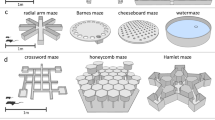Abstract.
Insects inhabit extreme temperature environments and have evolved mechanisms to survive there. Small insects are especially susceptible to rapid changes in body temperature. Therefore, the rapid detection of environment and body temperature is important for their survival. Little, however, is known about the thermosensors that detect those temperatures. Using rapid thermosensitivity assays with temperature step gradients and a spatial learning paradigm (the heat-box) in which elevated temperature serves as the negative reinforcer, two thermosensors were identified and their behavioral functions assessed. A low-temperature thermosensor is located on the antenna, detects relatively low temperatures, and can detect spatial temperature gradients directly. Thus, the antennae can be used by Drosophila to quickly orient with respect to temperature cues. A high-temperature thermosensor of unknown location appears to have a roughly similar sensitivity to temperature differences as the low-temperature thermosensor (≤3°C) and is both necessary and sufficient for memory formation in the heat-box spatial learning paradigm. Therefore, the high-temperature thermosensor is important for remembering spatial positions in which dangerously high temperatures were encountered.
Similar content being viewed by others
Author information
Authors and Affiliations
Additional information
Electronic Publication
Rights and permissions
About this article
Cite this article
Zars, T. Two thermosensors in Drosophila have different behavioral functions. J Comp Physiol A 187, 235–242 (2001). https://doi.org/10.1007/s003590100194
Accepted:
Issue Date:
DOI: https://doi.org/10.1007/s003590100194




